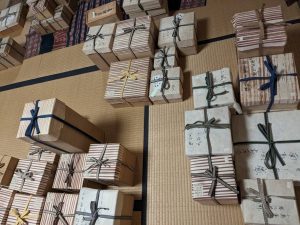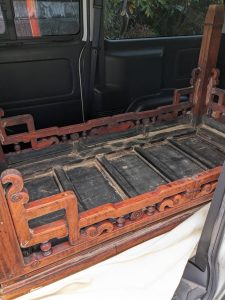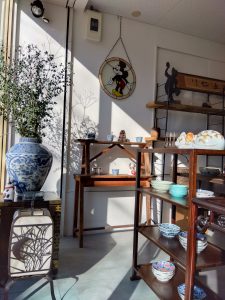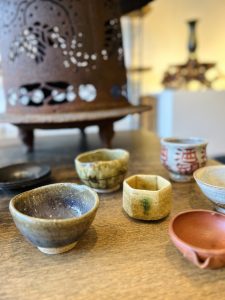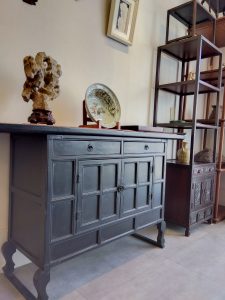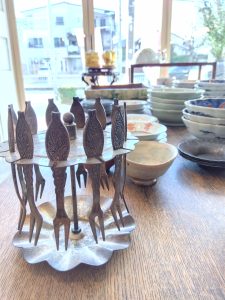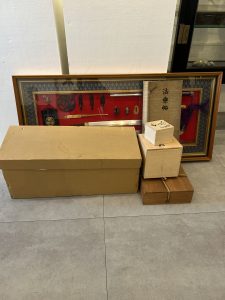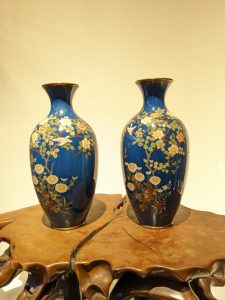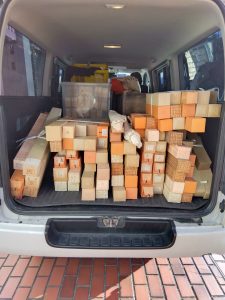みなさまこんにちは、スタッフYでございます。
このところ連日寒い日が続いておりますが、皆さまのお宅はどのように暖をとっておりますでしょうか。
石油ストーブ、エアコン、ガスファンヒーターなどなど様々でありましょうが、我が家はエアコン、床暖、時々ガスファンヒーターなど、いろいろ使い分けタイプであります。昨今の震災の状態を思いますと暖をとれることに感謝しかないのですが、本日は先日訪れたところのちょっと暖かい呟きをいたしますので、少し暖まっていってください。
前日、遠方からのお客様と共に覚王山界隈巡りを致しまして。その際に古美術風光舎のご近所でもあります「揚輝荘」へ行って参りました。
「揚輝荘」
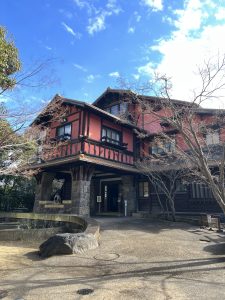
赤い壁にハーフティンバーが印象的
揚輝荘は、昭和初期に建設された名古屋の郊外別荘の代表作でして、別荘の主人はあの名古屋にあります百貨店、松坂屋の初代社長である伊藤次郎左衛門祐民氏であります。
大正から昭和初期にかけ覚王山の丘陵地1万坪に、建物と庭園がつくられ、当時は、政財界、文化人だけでなく、留学生も含めた国際的な交流の場となっておりました。現在は名古屋市を代表する歴史的建造物として、5つの建造物が市指定有形文化財に指定されましした。当時の敷地の模型を拝見しましたが、テニスコートがあったり、乗馬もできたしりたようですね、今では想像できませんが。
今回は、その中でも赤の景観で象徴的な建造物「聴松閣」の内部へ。
昭和12年に揚輝荘の迎賓館として建てられたハーフティンバー様式の洋館なのですが、平成25年に修復整備を終え、地階~2階を公開。1、2階は英国や中国風の意匠を取り入れた各部屋があり、印度様式の地階には、壁画やホール、舞踏場があり、現在は講演会やコンサートなどを開催することも可能であります。
この建物の面白い所は当時の最高峰の建築技巧を凝らした「ミックス」でしょうか。政財界、文化人だけでなく、留学生も含めた国際的な交流の場となっておりましたので、それぞれのお部屋には各国の様式がミックスされており、また、床や壁、建具などなど細部に至って様々な意匠が施され、伊藤次郎左衛門祐民氏の夢や思いがいっぱい詰まった見どころがたくさんあります。こんなこところに謎の入り口?とか何用の戸棚なのだ?といったディテールが憎い箇所が多々あり、いつどこを見学してもわくわくして、個人的にはいろいろツボります。
その中でも今回印象的たっだのが「暖炉」。ここでやっと暖かい呟きにもどりますが、寒かったのもあり暖炉がとても気になりました。各部屋の暖炉が、各国の様式になぞらえて作られており、とても面白かったので、少しご紹介いたしましょう。
こちらは、旧居間の暖炉。腰壁タイル目地に金箔を貼った仕上げになっており、何気に豪華です。
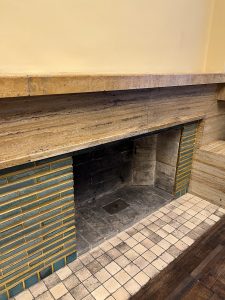
こちらは、旧食堂の暖炉なのですが、よく見ると東寺の古代瓦がはめ込んであります。暖炉の炎の前で、日本の建物の話などがはずんでいたのでしょうか。
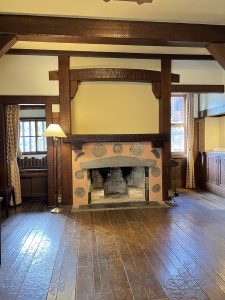
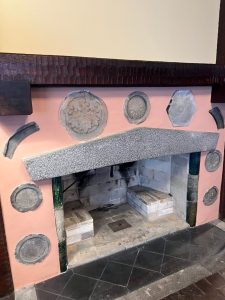
こちらは旧応接室の暖炉。イギリスの山荘風の客間として使われていたようですが、窓辺の丸窓とソファは一等船室のイメージでインドやヨーロッパを旅した伊藤氏の思い出に浸る場所だったのでしょうか。座らせていただきましたが、この囲われ感がなぜか落ち着く笑。
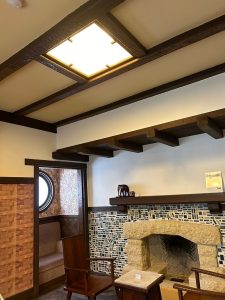
こちらは、旧寝室Bの中国様式の暖炉。雷紋の床、天井の鳳凰、暖炉の上の木鶏など、中国ですね。

天井も豪華ですね。
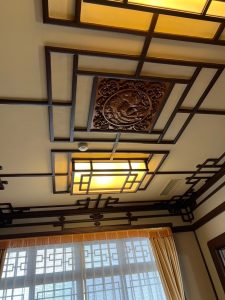
そして、地下室にあります旧舞踊場の暖炉。地価はカンボジアやインドネシアを意識した装飾になっているのですが、暖炉の上にはカンボジアのアンコールワットに見られる踊り子のレリーフで装飾しております。
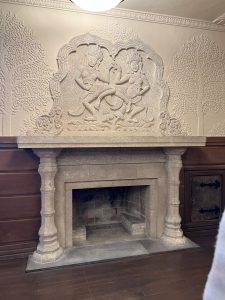

暖炉の衣装には流派や決まりなどはないですからそのバリエーションにはちょっと驚きましたが、それぞれに訪れた地に思いを馳せ、また、伊藤次郎左衛門祐民氏の思い出も詰まったようなどれも違ったデザインになっており、とても面白い。
当時もこの暖炉の炎を囲んで、財界人や留学生たちが夢に満ちた談笑をしたり、ダンスを楽しんでいたのでしょう。そんな様子が思い浮かぶようなそれぞれの暖炉でありました。
それはそうと、暖のとり方の話に戻りますが、「え?うちは暖炉で暖をとってますよ。」と、言う方もいらっしゃるのではないでようか。
こちらの「揚輝荘」の暖炉ではないですが、暖炉のある空間とはなぜにこのように豪華になるのか。自分にとって暖炉を囲む暮らしなんて憧れ中の憧れなのですが、こちらの数々の暖炉を眺めていますとその憧れは更に遠い存在になっていくようでありました。
それではごきげんよう。
Hello everyone, this is Staff Y.
It has been cold every day recently. How do you keep your house warm?
We use various types of heaters such as oil heaters, air conditioners, gas fan heaters, etc. We use air conditioners, floor warmers, and sometimes gas fan heaters. When I think of the recent earthquake and tsunami, I can only be thankful that we are able to keep warm, but today I would like to share a little warmth from a place I visited the other day.
The day before, I had a tour of the Kakuozan area with a client from far away. On that occasion, we went to “Yangkisou,” which is also a neighbor of Fukousha Antiques.
Yangkisou”.
Impressive red walls and half-timbers
The owner of the villa was Mr. Yutami Ito Jirozaemon, the first president of Matsuzakaya, a department store in Nagoya.
The building and garden were constructed from the Taisho era (1912-1926) to the early Showa era (1926-1989) on the hillside of Kakuozan, and at that time it was a place for international exchange, not only among political and financial figures and cultural figures, but also among foreign students. Today, five of the buildings are designated as Tangible Cultural Properties by the city as representative historical buildings of Nagoya City. I saw a model of the site at that time, and it seems that there were tennis courts and horse riding facilities, which is hard to imagine now.
This time, we went to the interior of “Hearing Song Pavilion,” one of the most iconic buildings in the city with its red landscape.
The first and second floors have rooms with English and Chinese designs, and the basement, which is in the Indian style, has murals, a hall, and a ballroom, where lectures, concerts, and other events can be held. It is also possible to hold lectures and concerts.
The most interesting feature of this building is the “mix” of the best architectural techniques of the time. The building was a place for international exchange, not only for political, business, and cultural figures, but also for foreign students, so each room is a mix of styles from different countries, and the floors, walls, fittings, and other details have various designs. The floor, walls, fittings, etc., are all designed in various details. A mysterious entrance here and there? What is this cupboard for? I am always excited to visit any part of the house, and personally, I am always impressed by various points of interest.
Among them, the “fireplace” was the most impressive this time. I am finally going back to my warm musings here, but I was very interested in the fireplaces because of the cold weather. The fireplaces in each room were made in the style of each country, which was very interesting, so let me introduce a few.
This is the fireplace in the old living room. The joints of the tiles on the hip wall are finished with gold leaf, which is quite luxurious.
This is the fireplace in the old dining room, and if you look closely, you can see ancient tiles from Toji Temple inlaid in the fireplace. Perhaps they were talking about Japanese buildings in front of the flames of the fireplace.
This is the fireplace in the old drawing room. The round window and sofa in the window area remind me of a first-class cabin, and I wonder if this was a place for Mr. Ito to soak in memories of his travels in India and Europe. I was allowed to sit down, and for some reason this sense of enclosure made me feel at home lol.
This is the Chinese style fireplace in the old bedroom B. The lightning patterned floor, the phoenix on the ceiling, the wooden chicken above the fireplace…it’s Chinese.
The ceiling is gorgeous.
And the fireplace of the former dance hall in the basement. The land value is decorated with Cambodia and Indonesia in mind, and the fireplace is decorated with reliefs of dancers seen in Angkor Wat in Cambodia.
There is no school or rule for fireplace costumes, so I was a bit surprised at the variations, but they are all very interesting because they all have different designs, each reminiscent of the places visited and also filled with memories of Yutami Jirozaemon Ito.
Even in those days, businessmen and foreign students must have enjoyed chatting and dancing around the flames of this fireplace, filled with dreams. Each fireplace reminded me of such a scene.
That said, back to the topic of how to keep warm. We heat our house with a fireplace. I guess there must be some people who say, “Yes, we use a fireplace to keep warm.
This is not the fireplace at “Yanghui So” here, but I wonder why a space with a fireplace is so luxurious. For me, living around a fireplace is something I have always longed for, but looking at the many fireplaces here, it seems that my longing for such a life has become even more distant.
Good day to you all.
*******************
ご実家の整理やお片付けなどをされている方のご相談などが多くございます。
お片付けなどくれぐれもご無理のないようになさってくださいませ。
風光舎では古美術品や骨董品の他にも絵画や宝石、趣味のお品など様々なジャンルのものを買受しております。
お片付けをされていて、こういうものでもいいのかしらと迷われているものでも、どうぞお気軽にご相談下さいませ。
また風光舎は、出張買取も強化しております。ご近所はもちろん、愛知県内、岐阜県、三重県その他の県へも出張いたします。
まずは、お電話お待ちしております。
愛知県名古屋市千種区姫池通
骨董 買取
【古美術 風光舎 名古屋店】
TEL052(734)8444
10:00-18:00 OPEN
